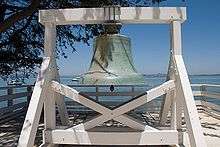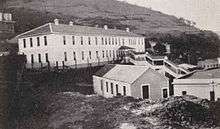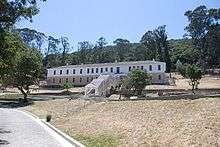Angel Island Immigration Station
|
Angel Island | |
 Angel Island Dormitory | |
  | |
| Nearest city | Tiburon, California |
|---|---|
| Coordinates | 37°52′11″N 122°25′34″W / 37.869712°N 122.426006°WCoordinates: 37°52′11″N 122°25′34″W / 37.869712°N 122.426006°W |
| Area | 731.8 acres (296.1 ha) |
| Built | 1775 |
| Architect | Unknown |
| Architectural style | Mission/Spanish Revival |
| NRHP Reference # | 71000164[1] |
| Significant dates | |
| Added to NRHP | October 14, 1971 |
| Designated NHLD | December 9, 1997[2] |
Angel Island Immigration Station was an immigration station located in San Francisco Bay which operated from January 21, 1910 to November 5, 1940,[3] where immigrants entering the United States were detained and interrogated. Angel Island (California) is an island in San Francisco Bay. It is currently a State Park administered by California State Parks and a California Historical Landmark. The island was originally a fishing and hunting site for Coastal Miwok Indians, then it was a haven for Spanish explorer Juan Manuel de Ayala. Later, it was developed as a cattle ranch, then, starting with the Civil War, the island served as a U.S. Army post. During the island's Immigration Station period, the island held hundreds of thousands of immigrants, the majority from China, Japan, India and the Philippines. The detention facility was considered ideal because of its isolated location, making it very easy to control immigrants, contain outbreaks of disease, and enforce the new immigration laws.[4] The station is listed on the National Register of Historic Places under the title Angel Island, U.S. Immigration Station.
History



Angel Island Immigration Station, sometimes known as "Ellis Island of the West," began construction in 1905 in an area known as China Cove. The main difference between Ellis Island and Angel Island was that the majority of the immigrants that traveled through Angel Island were from Asian countries, such as China, Japan, and India. The facility was created to monitor the flow of Chinese immigrants entering the country after the implementation of the Chinese Exclusion Act in 1882. The Act only allowed entrance to merchants, clergy, diplomats, teachers, and students, barring laborers.[4] The Act did give the government an idea of how to begin to regulate immigration, and realize the potential effect of immigration on the economy.
At Ellis Island, only between one and three percent of all arriving immigrants were rejected; at Angel Island, the number was about 18 percent.[5] The Chinese were targeted due to the large influx of immigrants that were arriving in the United States. Chinese immigrants were seen as a threat because they occupied low-wage jobs, and after the economic downfall during the 1870s, Americans experienced serious unemployment problems. This resulted in increased discrimination against the Chinese, labeling them as unsuitable Americans due to their appearance and social status. After executing a series of restrictive laws prohibiting the majority of Chinese immigration, the detention center was opened in 1910. Immigrants arrived from 84 different countries, with Chinese immigrants accounting for the largest ethnic group to enter San Francisco until 1915 when Japanese immigrants outnumbered the Chinese for the first time.[4]
Process
The length of time immigrants spent detained varied depending on how long the interrogation process lasted. For some it was only a few days and for others it lasted for months, the longest recorded stay being 22 months.[6] This was significantly different from Ellis Island which had more relaxed regulation, and allowed immigrants to enter the United States within the day they arrived at the Island. Interrogations lasted awhile because many of the immigrants held at the detention center had false paperwork. Chinese immigrants, mostly males, claimed to be sons of Chinese individuals who were American citizens. Since children of citizens are also considered U.S. citizens, regardless of where they are born, it is illegal to deny them entry if they can prove citizenship. Therefore, the concept of “paper sons” or less commonly “paper daughters” was constructed- children on paper, but without real familial ties. Chinese-American citizens agreed to this collaboration because they were provided with monetary incentives.[4]
As a result, the interrogation process was established to be very difficult and grueling to weed out the fraudulent individuals. The applicant would be called before a Board of Special Inquiry, composed of two immigrant inspectors, a stenographer, and a translator, if needed. Over the course of a few hours or days, the individual would be drilled with specific questions that only real applicants would know about, for instance, their family history, location of the village, their homes and so on. However, a way around these questions was preparing them months in advance with their sponsors and memorizing the answers. To ensure that the applicant was telling the truth, witnesses from the United States, who were often other family members, were called in to corroborate the applicants story. The “family members” sometimes lived across the country, which extended the process since their testimony had to be verified before proceeding. If there was any doubt that the applicant was lying then the questioning process was prolonged and if deviation was suspected from the testimony presented by the witnesses, then the applicant and the rest of the family would be in jeopardy of deportation.[7]
Some applicants appealed the decision of the Board, resulting in a prolonged stay at the detention center because the process was so long and tedious. Additionally, the length of stay varied depending on what country the individual was coming from. Japanese immigrants often held documentation from government officials that expedited the process of entering the country. This resulted in the majority of detainees being Chinese since they had no other alternatives but to endure the questioning. Since the goal of Angel Island was to deport as many Chinese immigrants as possible, the whole process was much more intrusive and demanding for the Chinese compared to other applicants.[7]
Outcome
The detention center was in operation for thirty years; however, there were many concerns about the sanitation and safety of the immigrants at Angel Island, which proved to be true in 1940 when the administration building burned down. As a result, all the immigrants were relocated to another facility. Since Congress repealed the Chinese Exclusion Act in 1943, the facility was not reopened as an immigration station. Instead, during World War II it served as a prisoner of war processing center by the U.S. military. After the war, Angel Island was abandoned and deteriorated. It wasn’t until 1963 that the detention facility was converted to a state park and a museum commemorating the immigrants that passed through. However, the building was set for demolition until someone discovered verses the detainees wrote on the wall. Today, more than 200 poems have been recovered and restored, and all but the detention centers are currently available to the public.[7] It is approximated that one million immigrants were processed at Angel Island Immigration Station, roughly 175,000 were Chinese and 117,000 were Japanese. Between 75-82 percent entered America successfully.[6]
Immigrant perspectives

The predominantly Chinese immigrants who were detained at Angel Island were not welcomed in the United States. As recounted by one detained in 1940: “When we arrived, they locked us up like criminals in compartments like the cages at the zoo.” Held in these “cages” for weeks, often months, individuals were subjected to rounds of long and stressful interrogations to assess the legitimacy of their immigration applications. Immigrants were made to recall minute details about their home and claimed relations—how many steps led up to your front door? Who lived in the third house in the second row of houses in your village? The interpreters for the proceedings may have not have spoken the particular dialect of the immigrant competently; most Chinese immigrants were from southern China at that time, many spoke Cantonese. It was difficult to pass the interrogations, and cases were appealed many times over before one could leave the island and enter the United States. Often, successful immigrants produced elaborate instruction manuals that coached fellow detainees in passing interrogations; if anyone was caught with these manuals, they would most likely be deported. Those that failed these tests often feared the shame of returning to China, and would commit suicide before leaving, or on the ships back to their homeland.[8]
Many of the detainees turned to poetry as expression, spilling their emotions onto the very walls that contained them. Many of these poems were written in pencil and ink, or in brush, and then carved into the wooden walls or floors.[9] Some of the poems are bitter and angry, placid and contemplative, or even hopeful.
- “America has power, but not justice.
- In prison, we were victimized as if we were guilty.
- Given no opportunity to explain, it was really brutal.
- I bow my head in reflection but there is nothing I can do.”
Another example:
- “I thoroughly hate the barbarians because they do not respect justice.
- They continually promulgate harsh laws to show off their prowess.
- They oppress the overseas Chinese and also violate treaties.
- They examine for hookworms and practice hundreds of despotic acts.”[10]
A more hopeful example:
- "Twice I have passed through the blue ocean, experienced the wind and dust of journey.
- Confinement in the wooden building has pained me doubly.
- With a weak country, we must all join together in urgent effort.
- It depends on all of us together to roll back the wild wave." [9]
These poems are immensely important to architectural history, as they are the physical remnants that tell the story of these people and their memories.
See also
- California Alien Land Law of 1913
- Immigration and Nationality Act of 1952 (McCarran-Walter Act)
- Immigration and Nationality Act of 1965
- Immigration Reform and Control Act of 1986
- Immigration Act of 1990
- Tye Leung Schulze; the first Chinese American civil servant in the United States, who worked at Angel Island.
- Tyrus Wong, imprisoned on Angel Island when he was 9, he was later released and became the chief artist for Disney's Bambi.
- Paper Sons
References
- ↑ National Park Service (2010-07-09). "National Register Information System". National Register of Historic Places. National Park Service.
- ↑ California NHL List
- ↑ "The History of Angel Island: The Ellis Island of the West". San Francisco Travel. Retrieved 2015-12-15.
- 1 2 3 4 "United States Immigration Station (USIS)". angelisland.org. Retrieved 29 September 2014.
- ↑ Howard Markel and Alexandra Minna Stern, “Which Face? Whose Nation?” American Behavioral Scientist 42, no. 9 (June/July 1999): 1318; Roger Daniels, “No Lamps Were Lit for Them: Angel Island and the Historiography of Asian American Immigration,” Journal of American Ethnic History 17, no. 1 (Fall 1997).
- 1 2 Chow, Paul. "Angel Island" (PDF). americansall.com. Americans All. Retrieved 29 September 2014.
- 1 2 3 "Life on Angel Island". aiisf.org. Angel Island Immigration Station Foundation. Retrieved 29 September 2014.
- ↑ Yu, Connie Young. "Rediscovered Voices: Chinese Immigrants and Angel Island." Amerasia Journal Vol. 4, No. 2 (1977), pp. 131.
- 1 2 Lai, Him Mark, Genny Lim, and Judy Yung. Island: Poetry and History of Chinese Immigrants on Angel Island 1910-1940. Seattle: U of Washington, 1991. Print.
- ↑ Island: Poetry and History of Chinese Immigrants on Angel Island, 1910–1940 written by Him Mark Lai, Genny Lim, and Judy Yung
External links
| Wikimedia Commons has media related to Angel Island, U.S. Immigration Station. |
- Angel Island State Park official website
- Angel Island Immigration Station Foundation - the non-profit partner of California State Parks and the National Park Service in the work to restore the historic immigration station at Angel Island.
- Angel Island Conservancy - Established in 1975, AIC’s primary mission is to facilitate the preservation, restoration and interpretation of historical and natural resources on Angel Island, with the goal of enhancing the visitors’ experiences and building a community to support AISP.
- U.S. Immigration Station Tours
- Early History of the California Coast, a National Park Service Discover Our Shared Heritage Travel Itinerary
- Angel Island Company, State Parks concessionaire for tours, bike rentals, and catered picnics
- Historic American Buildings Survey (HABS) No. CA-1841, "Camp Reynolds, Angel Island State Park, Angel Island, Marin County, CA", with 14 other entries for individual buildings
- Angel Island materials in the South Asian American Digital Archive (SAADA)

